[NGW Magazine] Canada's First Nations Come Onside
The Canadian gas industry awaits FID on the country’s first major LNG projects, as First Nations support is now assured. It has been a bumpy journey though, often adding to the costs by extending the planning process and involving compensation packages.
All eyes in the western Canadian gas industry are fixed firmly on Anglo-Dutch major Shell and its four joint venture partners in LNG Canada as they prepare to take FID – perhaps as early as this fall – on a C$40bn (at least), 13mn metric tons/year gas liquefaction terminal at Kitimat, on British Columbia’s northern coast.
The pending FID for LNG Canada – which could become the first world-scale natural gas liquefaction project in Canada – was certainly front and centre at the mid-May Canada Gas & LNG Conference in Vancouver – more than 1,400 road km south of Kitimat, but less than half that by air. And while delegates were not treated to the long-awaited FID announcement, they did hear LNG Canada CEO Andy Calitz reaffirm a commitment he made in 2016 – when Shell announced FID would be delayed two years – to have shovels in the ground at the project site this year.
“That was probably one of the most difficult days of my whole energy career,” Shell gas project veteran Calitz recalled during a panel discussion at the conference. “But when we were asked the inevitable question of when we would reconsider FID, our answer was we will be constructing in 2018 – and I reaffirm that commitment today.”
LNG Canada – with joint venture participants Shell, Malaysian Petronas, PetroChina, Korea’s Kogas and Japan’s Mitsubishi – and its companion Coastal GasLink pipeline, which will connect the JV participants’ own Montney gas reserves in northeastern BC to Kitimat, together enjoy the highest profile amongst the emerging LNG industry in Canada. Not so long ago it boasted at least 20 planned projects, most of them on the west coast, just 11 days’ journey to Asian LNG markets.
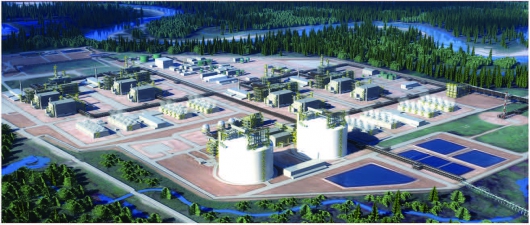
LNG Canada project site - south view (Credit: LNG Canada)
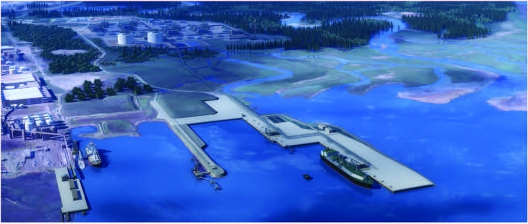
LNG Canada project site - north view (Credit: LNG Canada)
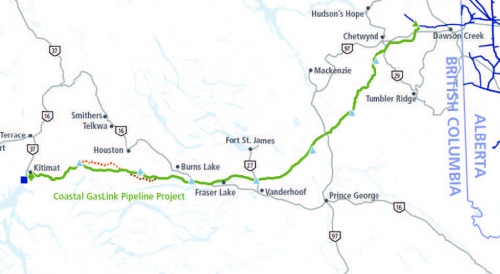
Coastal GasLink route map (Credit: TransCanada)
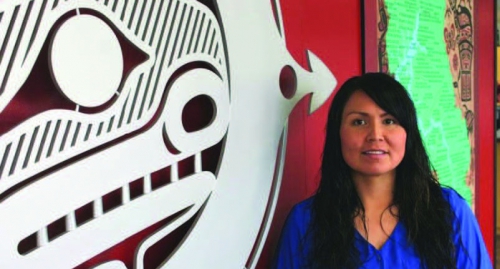
Haisla Nation chief councillor Crystal Smith (Credit: First Nations LNG Alliance)
But an industry that was touted by former BC premier Christy Clark as offering a $100bn bonanza to the province is now a shadow of its former self. Those 20 proposals have shrunk to a handful of world-scale export projects, including LNG Canada, the 10mn mt/yr Kitimat LNG project (Chevron-Woodside) a mile or so up the Douglas Channel from LNG Canada’s site; Steelhead LNG’s 24mn mt/yr Kwispaa LNG project on Vancouver Island, and WCC LNG, a 30mn mt/yr facility at Prince Rupert proposed by ExxonMobil and Imperial Oil Resources that is still in the environmental review process.
Likely to beat them all to market, however, is Woodfibre LNG, a “modestly-sized” C$1.8bn liquefaction facility on the site of a former pulp mill near Squamish, 64 km north of Vancouver. It is licensed to export some 2.1mn mt/yr of LNG and could be operational as early as 2020 or 2021, at least two years ahead of LNG Canada, if FID on the latter is taken this year.
In a keynote address to the Vancouver conference, the president of the BC LNG Alliance, whose seven members are still actively pursuing gas liquefaction opportunities in the province, pointed to both Woodfibre’s aspirations and LNG Canada’s pending FID as proof that LNG in BC is far from dead. “Contrary to what you may have read or heard in the media or from various pundits over the past few years, the BC LNG industry is very much alive, and our industry has continued to move forward even as we saw a downturn in global LNG markets and pricing,” David Keane said. “Our members have continued to develop and invest in their projects, and we are hopeful that we will see two final investment decisions later this year.”
A key reason the BC LNG industry remains viable, conference delegates heard over three days of presentations and panel discussions, is that natural gas infrastructure development in the province – unlike projects associated with bitumen produced in Alberta and piped to tidewater near Vancouver – enjoys strong support from BC First Nations.
More than 50 First Nations are directly impacted by the natural gas industry in BC, from production fields in the northeast to planned pipelines crossing traditional First Nations territories to proposed export terminals on lands leased from First Nations. And almost without exception, those First Nations see LNG developments in the province as a form of “economic reconciliation” – a way to make amends for past transgressions surrounding resource developments in traditional Aboriginal territories.
“LNG development offers economic reconciliation to heal our members from the impacts of past resource developments,” Crystal Smith, chief councillor of the Haisla Nation, in whose traditional territory both the LNG Canada and Kitimat LNG projects will be built, said in a panel discussion. “It’s a chance for our members to lift themselves out of poverty and addictions and to heal in a cultural aspect.
The showpiece of collaboration between the LNG industry and BC’s First Nations is the First Nations Limited Partnership (FNLP), a benefits agreement between Kitimat LNG and the 16 First Nations – including Smith’s Haisla Nation – whose territories are traversed by the 480-km Pacific Trail Pipeline (PTP), the final stage of the pipeline network that will deliver feed gas to Kitimat LNG from Chevron’s and Woodside’s reserves in the Liard and Horn River basins in the far northeastern corner of BC.
“The FNLP agreement was ground-breaking in the scale, and manner, of financial benefits payments to its member First Nation communities,” Mark Podlasly, a member of the Nlaka’pamux Nation and chairman of the FNLP, told NGW. “A significant financial payment was made to each First Nation upon signing the commercial benefits agreement at the beginning of 2013 – a payment which had no strings attached, with each First Nation having absolute discretion over the use of the monies.”
But such agreements are not unique to the Kitimat LNG project. Coastal GasLink, the 670-km pipeline that will supply the LNG Canada terminal at Kitimat, has worked to develop partnerships with 20 First Nations since the June day in 2012 that TransCanada was awarded the project, president Rick Gateman told the conference.
“Over the course of the last few years we’ve come up with a relatively innovative strategy that we think mimics equity participation in the pipeline,” he said. “The two key components of that would be a say over what happens on their traditional territory as the pipeline is built and maintained over the years and a revenue source that is generated from us crossing that traditional territory.”
That focus, Gateman said, has resonated with BC’s Aboriginal community, and Coastal GasLink now has long-term agreements with 95% of the First Nations on the right-of-way and expects to have 100% support by the time shovels hit the ground, should LNG Canada take FID this year. “I think that’s a mighty big achievement, especially in an area of unceded title that has very little in the way of treaties to work with.”
Dan George is chief of the Ts'il Kaz Koh First Nation at Burns Lake, which is traversed by both the PTP and Coastal GasLink projects. He is also chairman of the First Nations LNG Alliance, whose members include many of those Nations which have signed long-term benefits agreements tied to Coastal GasLink.
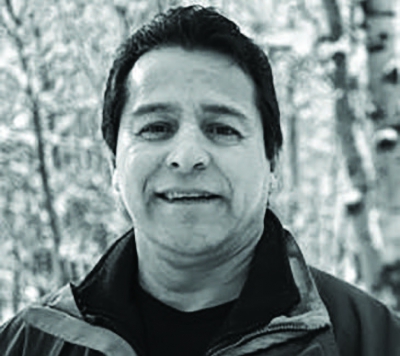
Chief Dan George (Credit: First Nations LNG Alliance)
For his community, and for all members of either the First Nations LNG Alliance or the FNLP, LNG developments are a “once in a lifetime opportunity” for First Nations to raise their standard of living. “I call it the 6 & 63 paradigm,” George told the conference. “Right now, Canada is ranked 6th in terms of global standard of living; Canada’s First Nations are ranked 63rd – we need to close that gap, and actively supporting and participating in LNG development is a way to help close that gap.”
On Vancouver Island, the Huu-ay-aht Nation has taken First Nation support for LNG development to the highest level attainable, striking a co-management agreement with Steelhead LNG in 2017 for the development of the Kwispaa LNG project on its traditional territory near Sarita Bay on the island’s west coast.
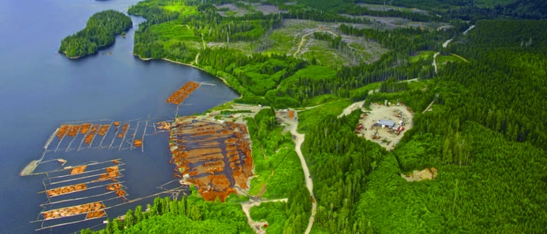
Sarita Bay (Credit: Steelhead LNG)
The project received 70% support from Huu-ay-aht members in a referendum and has the full backing of both the First Nation’s hereditary chiefs and its elected executive council. “One of the reasons we supported Steelhead LNG is that prior to any development activity, they approached us and said they were interested in developing a project on our land,” Huu-ay-aht chief councillor Robert Dennis told the conference. “We have taken action to make LNG happen – our government and industries now have to take the same action.”
Dale Lunan



